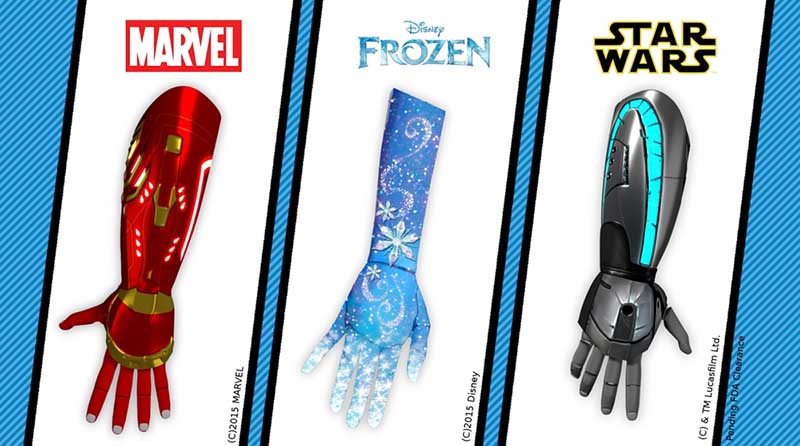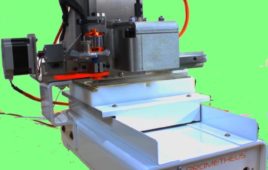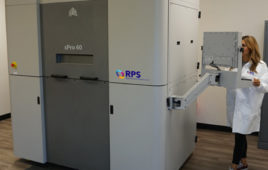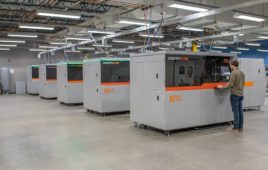3D printing is redefining many industries, and one of the places where it is really making an impact is in delivering a new generation of low-cost 3D-printed prosthetic hands and limbs.
In many cases, these new prosthetics are changing the lives of people who would otherwise be unable to afford the higher-end versions.
Various organizations are now helping to increase the availability of 3D-printed prosthetics.Enable Community Foundation is an organization pairing volunteers in the e-NABLE community with recipients and designs in order to provide free 3D-printed prosthetic hands to children with limb differences—providing not only functionality but also colors and designs kids actually want.
The Luke Hand is a new nonprofit whose mission is to create open-source bionic hands that offer advanced performance, using the collaborative CAD functionality that’s built intoAutodesk Fusion 360.
Additionally, exiii is a Japanese company that uses open-source technology to createmyoelectric hands. And Open Bionics is a UK-based company creating low-cost 3D-printed bionic hands that feature some functionality found in more expensive versions. The company even features Frozen, Star Wars, and Iron Man-themed hands for kids, too.

Courtesy Open Bionics
e-NABLE faces unique challenges because it is working with both volunteers and children. “The main challenge in working with children is they are constantly growing,” says Andreas Bastian, who is on the Enable Community Foundation board of directors and a 3D-printing research scientist at Autodesk. “A device that fits one day very likely won’t fit six months later. So 3D printing is remarkably well suited to this type of problem because it is so agile and it’s easy to adapt to make something custom-fit a recipient.”
The foundation helps connect kids in need with volunteers who can 3D print them prosthetic hands, but that requires the group to solve two critical issues simultaneously.
“We’ve made huge strides in manufacturability and assembly for the designs over the past two years,” Bastian says. “But most of these advances have been based on the needs of the fabricators who make the devices. Looking forward, we’d like to put a lot more emphasis on need-focused design, with attention to who the users are, what their local context is, what their cultural context is, and what type of a limb difference it is.”

Courtesy Enable Community Foundation
e-NABLE gained a lot of attention online once its volunteers started creating hands for kids that included pop-culture iconography.
“That is the big surprise, really,” says Jon Schull, who started the e-NABLE community and is now president and cofounder of the Enable Community Foundation, as well as a research scientist at Rochester Institute of Technology. “We had a 4-year-old with a huge smile, saying ‘I got my Iron Man hand,’ and he had received a hand that was Iron Man themed, and that took off like wildfire.”
Ever since that first hand, the volunteer community has been building superhero-themed hands and incorporating favorite colors into their designs. Similarly, The Luke Hand (whose name was inspired by the bionic replacement for Luke Skywalker’s severed hand in The Empire Strikes Back) is working to help make science fiction science fact in the field of bionics.
According to Schull, the sci-fi/superhero connection makes perfect sense. “It’s not a metaphor,” he says. “Every superhero has some kind of a flaw, and that becomes the basis for their superpower.
And these kids just get it, and it really changes their sense of themselves, as well as the way their peers interact with them. And, while we are proud of the mechanical functionality of these things, I frankly have come to believe that the social and psychological utility is at least as important.”
And there is a very pragmatic reason to get young people to adopt prosthetics.
“Using the 3D-printed devices at an early age develops the neural pathways, muscles, and tendons that are necessary to adapt readily if they want to use higher prosthetics at an older age,” says Enable Community Foundation CEO Grace Mastalli, who formerly worked at the Department of Justice and played a role in getting the Americans with Disabilities Act passed in 1990. “Not using—or, worse yet—hiding the amputated limb causes neural underdevelopment, and you end up with atrophied limbs.”
For Tetsuya Konishi, the head of design at exiii who left a job at Panasonic to join the company, it was also the human connection: Seeing Akira Morikawa, now the company’s evangelist, use the new hand for the first time really drove home the importance of this work.

Courtesy exiii
“When I saw him use the prosthetic hand that the three of us created, I had realized my true goal,” Konishi says. “I saw how happy he was with the prosthetic hand and how much joy it brought to me, being able to see a smile on the user’s face. At Panasonic, I was never able to see the user’s face.”
A common denominator of all the companies is that, unlike high-end prosthetics that aim to go more unnoticed, these 3D-printed versions are unabashedly artificial—even the ones not geared toward younger users.
“Prosthetic hands have always been designed to hide the fact that you’re missing a hand,” Konishi says. “But we want exiii prosthetics to be a channel for self-expression. Just like with watches or shoes, we want our prosthetics to be something users can wear as everyday products, to actually have fun with by choosing a specific design to suit their own fashion tastes.”
As more companies enter this space and embrace open-source business models, there is still a lot of work to be done when it comes to effective collaboration.
“Open source and hardware is still very much an unsolved problem and a very new territory,” Bastian says. “There aren’t a whole lot of successful projects to look to for guidance and precedence. Unlike software development, there are still some pretty staggeringly large barriers to collaboration on the design of physical things.”

Courtesy Enable Community Foundation
Bastian says many of the design tools used by the industry aren’t well suited to support open development and are often very expensive. This has driven many, from beginners to experts, toward products that are free, open source, or accessible, including Tinkercad, Fusion 360,Autodesk Meshmixer, and Blender.
“I am continually impressed with the fact that, despite those barriers, the amount of design innovation that comes from our encumbered amateur volunteers is a credible fraction of the innovation that we do,” Schull says.
File formats are also a barrier. “Choosing the right file format is very hard,” says Jonathan Raines, mechanical engineer at Open Bionics. “Most are shared as an STL, a format great for printing but terrible for editing. Everyone’s using different software, so it’s actually quite a difficult problem. Then there’s all the documentation that’s needed. If someone across the globe wants to pick up a design, they need to know why it looks like it does and what choices and trade-offs were made.”

Courtesy Open Bionics
But Raines is optimistic that collaboration is on the horizon.
“We’re excited to see what the open-source community will make with our latest updates,” Raines says. “Our first version was built by makers across the U.S., Canada, and Europe. This time, we’re releasing an updated version with a forum on our website so developers can share their builds and potentially contribute to our development.”
As these organizations mature; as the hardware and software that they use evolve; and as the potential of open-source, crowdsourced innovation is unlocked, it’s without question that huge breakthroughs are in store for the fields of prosthetics and bionics development.
This blog originally appeared on lineshapespace.com/3d-printed-prosthetics.
Filed Under: Rapid prototyping




